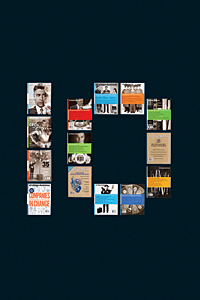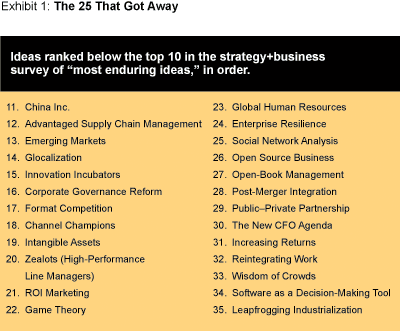In their 10th Anniversary issue, they researched the question: Of all the ideas "strategy+business magazine" has covered, which are most likely to endure for at least another 10 years?

Here are the winners - THE 10 MOST ENDURING IDEAS - voted most likely to affect the way we run our businesses.
1. EXECUTION (1,911 votes; 49.3 percent of the voters chose this concept). It’s not your strategic choices that drive success, but how well you implement them.
2. THE LEARNING ORGANIZATION (1,807; 46.6 percent). A learning organization is one that is deliberately designed to encourage everyone in it to keep thinking, innovating, collaborating, talking candidly, improving their capabilities, making personal commitments to their collective future, and thereby increasing the firm’s long-term competitive advantage.
3. CORPORATE VALUES (1,555; 40.1 percent). Companies that care about ethics, trust, citizenship, and even meaning and spirituality in the workplace (or that simply articulate their values carefully) perform better in the marketplace than companies that care just about “making money.”
4. CUSTOMER RELATIONSHIP MANAGEMENT (1,554; 40.1 percent). The cultivation of long-term relationships with customers, including awareness of their needs, leads to highly focused, capable companies that try to make consumers “part of the family.”
5. DISRUPTIVE TECHNOLOGY (1,513; 39.0 percent). As Clayton Christensen noted in The Innovator’s Dilemma, technological innovation radically alters markets by undermining incumbent companies — which are vulnerable because their offerings are all tailored to the needs of their existing customers.
6. LEADERSHIP DEVELOPMENT (1,432; 37.0 percent): You don’t have to rely on “putting the right people in place.” You can train all employees to be better choosers, better strategists, better managers, and in the end, better leaders.
7. ORGANIZATIONAL DNA (1,315; 33.9 percent): Leaders can design an organization’s structures — incentives, decision rights, reporting relationships, and information flows — to induce high performance by aligning them with one another and the strategic goals of the enterprise.
8. STRATEGY-BASED TRANSFORMATION (1,277; 33.0 percent): Beyond the “blank page” of reengineering, this is the redesign of processes and organizational structures, and the consequent cultural change, to fulfill the strategic goals of the enterprise. In an ideal universe, this would not even be a management concept, because, as one correspondent put it, “All company activities should be aligned to the enterprise strategy.”
9. COMPLEXITY THEORY (1,187; 30.6 percent): Markets and businesses are complex systems that can’t be controlled mechanistically, but their emergent order can sometimes be anticipated. An understanding of the ways that complex systems evolve can help managers intervene and act more effectively.
10. LEAN THINKING (1,183; 30.5 percent): This type of process and management innovation is exemplified by the Toyota production system. Employees use a heightened awareness of work flow and demand to cut waste, eliminate cost, boost quality, and customize mass production. Said one anonymous correspondent, “It combines with complexity theory, emergent behavior, wisdom of crowds, disruption, and agile thinking to extend into areas like R&D to redefine innovation practices. Management thinking will need to change to address these fertile intersections.”
…and...

I just love the work I do. The methodologies deliver every time. Phew!
No comments:
Post a Comment